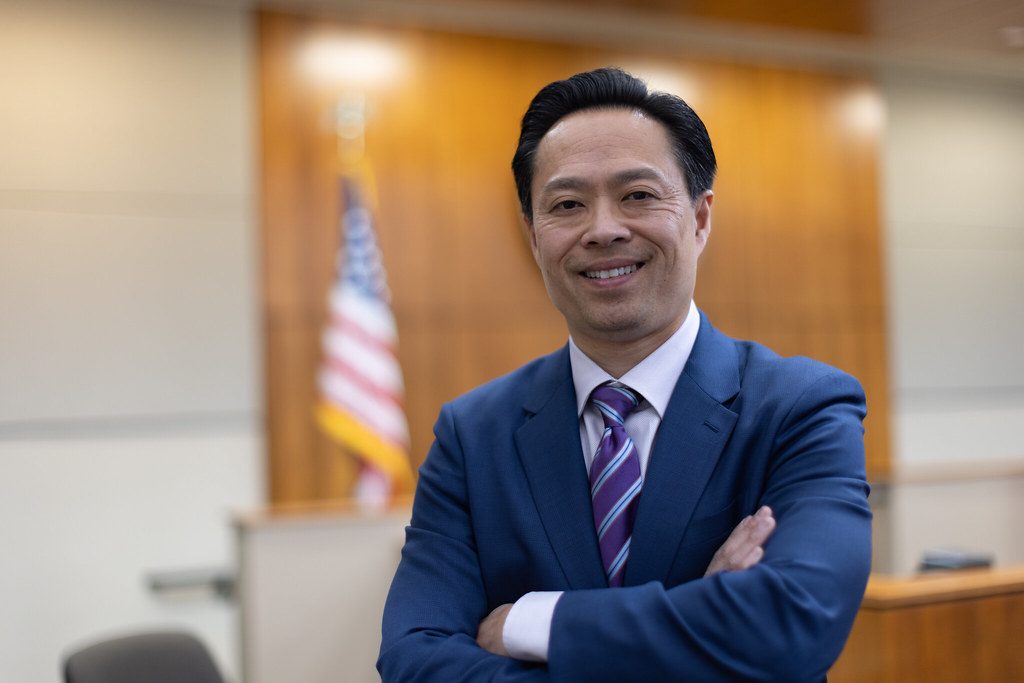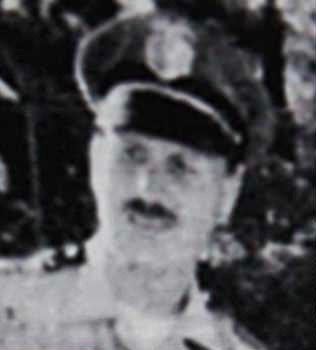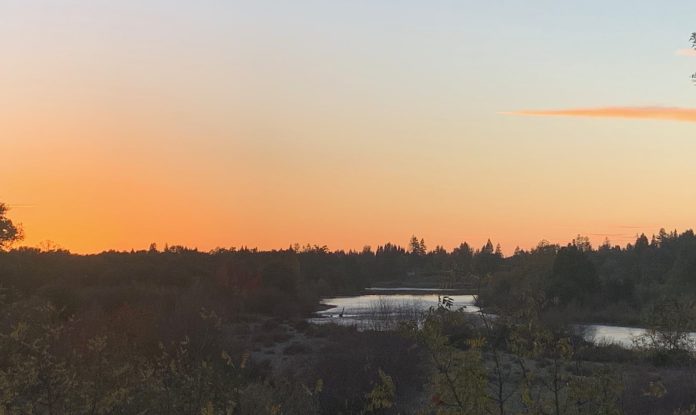District Attorney Thien Ho will host a public talk and book event at the Sacramento Public Library on Nov. 12
Between 1974 and 1986, Joseph DeAngelo cut a path of psychological destruction and barbaric murder across 11 counties and four regions in California.
He was the Visalia Ransacker who gunned down journalism professor Claude Snelling as he tried to prevent his 16-year-old daughter from being kidnapped by a masked assailant. He was the East Area Rapist who shot a military policeman and his 20-year-old wife while they were walking their dog in Rancho Cordova, the killings having followed his array of sexual assaults from Carmichael to Citrus Heights. He was the Original Nightstalker who tortured women tied down in their beds from Santa Barbara to Ventura, all before bludgeoning them to death with blunt objects from their houses. And he was the Golden State Killer who beat Janelle Cruz to death in her Irvine bedroom with a pipe, his force so savage that she couldn’t be recognized by those who found her.
Today, most investigators and attorneys just refer to him as GSK, or EAR/GSK.
DeAngelo didn’t just confound countless police detectives for 44 years, he also created the largest and most-complicated single criminal case in the history of the state. It was one that amounted to volumes and volumes of evidence to be prepared for a jury, not to mention having to explain how a then-novel DNA searching technique had finally identified the killer.
After tense discussions and reported in-fighting between several district attorney offices, the primary lawyer tasked with ending the case was Thien Ho, one of Sacramento’s top homicide prosecutors at the time with years of prior experience putting rapists behind bars.
Now, Ho – currently the elected District Attorney of Sacramento County – is opening up about the experience in his new book “The People vs. the Golden State Killer.” Ho says that he doesn’t think of his writing debut as being in competition with two other popular books on the subject, but rather as a genuine insider’s reveal of the twisting, turning legal saga that pushed law enforcement to its absolute limits.
To that point, he notes that ‘‘I’ll be Gone in the Dark” by the late Michelle McNamara was written before DeAngelo got caught and highlights a terror-effect that the perpetrator had on communities, while his colleague Paul Holes’ book “Unmasked” explores how the idea of using investigative genetic genealogy eventually led the serial killer’s downfall.
“My book sort of completes the trilogy – a third in the line that covers everything from the investigation, the capture and the prosecution,” Ho reflected while sitting down with SN&R at a Midtown café. “My focus has been on the victims and the generation of law enforcement that never gave up on this case. In my book, you’ll also see all of the dynamics that were going on behind the scenes, and the politics involved, which has never been revealed before, and the interplay of how that came out.”
Sacramento’s central library is hosting a public talk and book launch event with Ho on Wednesday, Nov. 12 between 6 and 7:30 p.m. in its Tsakopoulos Galleria on I Street. Survivors of the Golden State Killer are expected to be there and take part in the discussion.
A day that many believed wouldn’t come

Ho, a child refugee from South Vietnam who grew into a lawyer well-versed in Stoic philosophy, had been a homicide prosecutor in Sacramento for six years before he was handed the case of a lifetime. He and an assisting prosecutor, Amy Holiday (now Judge Holiday) would be the tip of the court spear for all of DeAngelo’s crimes, as well as coordinate with elements of a larger district attorney team that included Contra Costa, Santa Barbara, Ventura, Orange and Tulare counties.
Ho remembers having to study DeAngelo’s crimes in all of those jurisdictions, learning their details chapter-and-verse from the time the terror started in 1974.
There was no situation like it before in the annals of California justice.
That reality wasn’t lost on Ho.
“In terms of the scope of the case, there is nothing that comes close,” he observed. “We’re talking about 13 known murders, upwards of 50 sexual assaults and 120 burglaries that happened across 11 counties that were all up and down the state of California, all of them 30 to 40 years in the past. That means we’re talking about three million pages of discovery [evidence]. And all the investitive reports. And all the photographs. And all the videos.”
He added, “It was a tremendous amount of responsibility for all of us on that case, whether it was the investigators, or whether it was me, it was sobering … There were times when I would have to remind myself, how do you eat an elephant? One bite at a time.”
Ho was contemplating writing a book about DeAngelo’s case ever since the closing days of the proceedings, though navigating the pandemic, raising children and running for District Attorney took a front seat immediately following the conviction. When the now-D.A. did finally start typing up pages of his story, he’d do it for a couple hours each morning before work. Ho came up with a structure for the book that shifts back and forth through time, on one hand taking readers deep into each new investigation that started after DeAngelo committed a heinous act in the state through the 70s and 80s, and on the other hand lifting the veil on how detectives found him, and how Ho’s team prosecuted him between 2018 and 2020.
With that framework in mind, Ho wanted his front storyline to focus on the investigators, his secondary storyline to share parts of his immigrant story in California, and his third storyline to show how many of DeAngelo’s victims found their voices again as they confronted him in court. And Ho wanted to ultimately bring all of those threads together into a final, over-arching narrative.
Even an experienced nonfiction author could find nailing that framework daunting, but Ho had essentially spent two years having to meditate on how to pull off those same feats in front of a Sacramento jury. After DeAngelo avoided a trial by pleading guilty, writing a book was another way for Ho to bring his tactics to bear.
“My brain had already gone all the way to the end point and gamed it out to where I had to tell that story,” he mentioned.

In addition to true crime connoisseurs, “The People vs. the Golden State Killer” may also be a hit with California news junkies. That’s because Ho pulls no punches in describing the power struggles and gamesmanship that he says happened between different prosecuting offices around DeAngelo’s case. While some jurisdictions, like Ventura County, were extremely cooperative with outside investigators and deputy DAs, others were reportedly less so. Ho wasn’t an elected official at the time. For the most part, all he could do was watch how then-District Attorney Anne Marie Schubert and others handled the public-facing maneuvers.
“The politics presented another challenge,” Ho told SN&R. “And it’s interesting when you think of the transition between where I was then, and where I am now. Today, I’m always dealing with the political side, whereas before, I was reacting to it. In my current job, I get to kind of plan that out ahead of time. But back then, I was at the whim and fancy of the political nature of this case.”
Ho isn’t the only one who sees it that way. Paul Holes, a deputy sheriff criminalist in Contra Costa County who worked on the Golden State Killer investigation between 1994 and the day DeAngelo was arrested, has also lamented various district attorney personnel in some counties putting their own self-interests ahead of the truth.
“Over the course of my career, there have been repeated examples of how politics at the upper echelon of law enforcement stood in the way of investigators trying to solve this case,” Holes said to an audience that he was speaking in front of a few years ago.
The era Sacramento never forgets

Another mission that Ho had in writing his book was telling readers exactly who Joseph James DeAngelo Jr. really is: Decades of looming monikers can make the man seem larger than life on the internet. But Ho seems him differently. He views DeAngelo as a man with an admittedly tragic childhood, and a genital abnormality, who chose to cope with his discomfort by violating and tormenting innocent people and spreading pain to others on a level few could ever comprehend.
“We re-traced his life from the moment he was born all the way to when he was arrested,” Ho pointed out. “What I would say is that he had a God complex … He hunted human beings, and he was meticulous in his planning and everything he did. He would break into peoples’ homes and leave something in their seat cushions just to see if they find it before he broke back in again. He would be watching his prey, and monitoring them and planning it out. He felt so small, so insecure, so out of control of his own life, that he needed to play God and hold these peoples’ lives in the palm of his hand – it was his form of exerting control in a life where he had very little of his own.”
Ho added, “It was an obsession that he couldn’t feed enough, and he evolved as a monster.”

The nature of DeAngelo’s crimes makes for a tough discussion, but librarian Todd Deck, the Community Engagement Services Manager at Sacramento Public Library, says that his team is confident there’s strong public interest around getting to speak directly with the county’s District Attorney. Especially, he notes, about this topic.
“In Sacramento, true crime readers and listeners is a voracious community, and we’ve hosted other author events in the past in that genre, including Paul Holes and Barbara Rae-Venter, both of whom are mentioned in ‘The People vs. the Golden State Killer,’” Deck explained. “In those previous events, whenever the Golden State Killer came up, there were people in the audience who had very personal stories to share. So, I thought this would be an important conversation for the public to have. I also feel that Ho’s book covers a part of the story that really hasn’t been told yet. One of our core values at the library is being a place ‘where curiosity meets community,’ and this type of book really encapsulates that idea.”
As Ho prepares for his library appearance before heading out for other book events in the Midwest, he’s fairly sure he knows at least one question that will come from the audience.
“People always ask me, ‘Why did he stop?’ Ho remarked. “And my response is always, ‘How do you know he stopped?’ Because there is a period of time between his last known murder in Irvine in 1986, to 1989, where there is a black hole – a gap – around his whereabouts and what he was doing. It’s been lost to time.”
Ho also disputes the idea that, when finally arrested, DeAngelo was a decrepit, semi-invalid who was no longer a threat.
“At the age of 73, I have a video of him standing in his jail cell, looking out at a young, blond female worker that was delivering food in the pod, and he’s masturbating to her,” Ho emphasized. “Right before he was arrested, detectives were watching him carry heavy things around his yard.”
A final theme of “The People vs the Golden State Killer” is one of self-awareness. In recent years, it’s been increasingly acknowledged that police, firefighters and paramedics are constantly exposed to situations that have dire impacts on their mental health. However, Ho points out – both in interviews and in the pages of his book – that this is the case for anyone who works in the orbit of the criminal justice system. He thinks it would be better if there was an open dialog about that.
“As prosecutors, as first-line responders, as defense attorneys – even as crime journalists – you take in a lot of secondary trauma,” Ho said. “You’re reeling in and taking in the darkest part of the human recesses and experience. The only time I get to meet people, really, is in the darkest moment of their lives … In the book, I write about how, in England, they had the sin eaters, where they would hire people to come to funerals and eat a piece of bread, and that bread represented the sins of the individual who passed. It was not to absolve them of it, but just to take it in, so when they went to the afterlife they went, in a sense, of having someone that had eaten their sin. We do that in our jobs. We’re taking in the sins and the darkness of the world – and at some point, that has an effect on you.”
Five years have gone by since DeAngelo was hauled off to a state penitentiary where he’ll spend the remainder of his life. The nights of Ho waking up in the darkness from the stress of the case are past him. Now, the D.A. says he just wants to set the record straight for history about DeAngelo’s toll on so many lives.
“He’s in prison, I get tabs on him periodically about how he’s doing and where he’s at,” Ho said while wrapping up his interview. “The victim impact statements in this case were, to me, the most powerful I’d ever heard in my 25 years as a prosecutor. People ask me what I think about it now, that’s what I think about, the victims’ statements – not him. I hope this book is part of giving the victims a voice and taking back some of what was ripped away from them.”
Scott Thomas Anderson is also the writer and producer of the true crime podcast series “Trace of the Devastation.”




